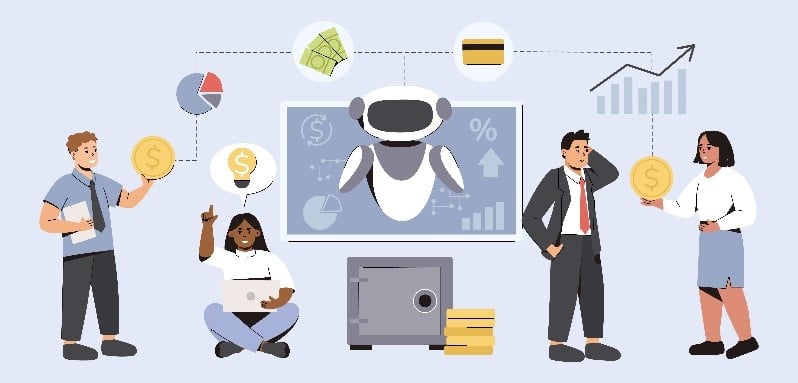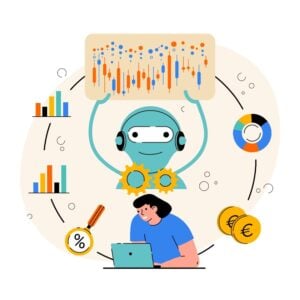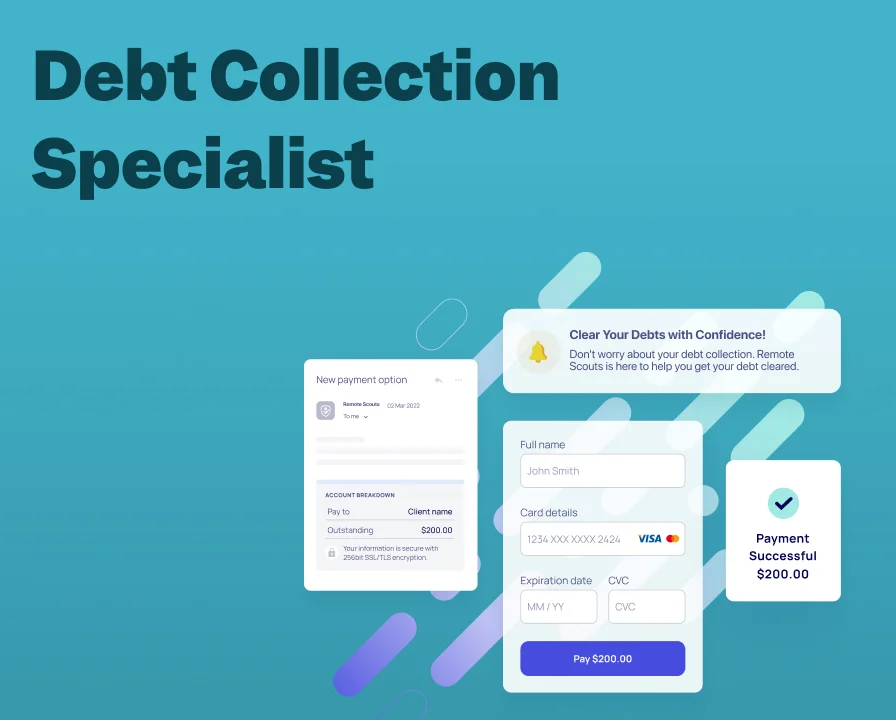The current technological advancements in Artificial Intelligence (AI) have revolutionized debt collections across the globe. Considering such advancements, the AI market is expected to reach $407 Billion globally by 2027, with its previous record of $86.9 Billion in 2022. Leaping the old manual processes that took days to complete the simplest of tasks to the current modernized automated workflow has indeed attested to the role of AI in debt collection.

Source: Freepik
Gone are the days of using legacy systems heavily integrated into consumer and commercial debt collection sectors. AI has shifted the core functionality of debt collection to a more streamlined operation system that encourages the collectors and instills confidence in the debtors. The reason for such heavy integration of AI in debt collection is that collection agencies worldwide have seen an average increase of 85% in recovery rates after incorporating AI in their debt collection strategies. The machine learning capabilities of AI-integrated systems allow companies to not only track their collections responsively but also equip them with behavior monitoring, debt predictive analysis, and custom-tailored debt strategies that make using AI for debt collection a more concrete case.
How AI Has Revolutionized Debt Collection
In such a fast-paced market, each firm focuses on leveraging all the tools and tricks available to them that can better optimize their accounts receivable. A vital responsibility of any competent collection agency is to keep up with the times and provide its customers with market-leading solutions. Remote Scouts is always at the front lines, analyzing industry trends and helping collection agencies increase revenue and streamline account receivables through AI. That being said, AI has modernized many aspects of debt collection in a few years, as 60% of collection agencies are on track toward implementing AI in their workflow. Such AI debt collection software implementations have become the industry standard, including data-driven decision-making, personalized customer engagement, predictive analysis, automated negotiations, compliance and regulatory adherence, etc.
Data-Driven Decision Making
Decision-making can be a tedious process for debt collection and account receivables as it involves multiple elements simultaneously. Not only this, but each decision causes a ripple effect that, in turn, gives you the basis for the rest of the decisions the agency will have to take regarding the entity at hand. The workflow of such a thought process, known as Data-Driven Decision Making (DDDM), is being used in debt recovery AI through a comprehensive analysis of the available data, directing related decisions by such data.

Source: Freepik
AI and DDDM- The Best of Both Worlds
In this regard, AI in debt collection has combined data-driven decision-making with behavior analysis and automated process recognition, allowing users to make the best possible decisions backed up with facts and figures.
Though the analysis of user insights has been standardized in debt collection for quite a while, integrating AI has revamped the operational basis of DDDM to the core, which has assisted in cash flow and rate of return.
Steps involved in DDDM
Considering the functionality of data-driven decision-making, the operations framework is based on a step-by-step process that has recently seen a makeover due to AI’s vital role in debt collection. Below is the procedure when a debt collection agency undergoes DDDM blended with AI trinkets.
Understanding your Vision
The first step involves analyzing the goals and setting benchmarks that align with the company’s vision for debt collections. Once done, AI debt forecasting can play a vital role in establishing a road map for the company to follow so that less time is consumed while keeping the pace of operations at an optimal rate.
Collecting Data
Once the firm has a clear vision of its goals and the amount of debt it is aiming to collect in the form of account receivables, relevant data is then sourced and collected, enabling the company to overview and better understand its vision through machine learning algorithms provided by AI in debt collection.
Organizing Data
Getting all the insights and analytics is one thing, but managing them at a core for streamlining operations can be a hectic task in debt collection, especially if done through manual labor. Therefore, AI in debt management has allowed companies to collect data consistently, reducing the risk of discrepancies while categorizing the debt collection analytics according to the user’s needs.
Data Analysis
In the current technological age, around 328.77 million terabytes of data are generated daily. Therefore, it can be tricky for collection agencies to analyze and process such heaps of data without proper automation tools. Thus, AI in debt collection can provide insights through data grouping, report generation, and insight gathering with precision and accuracy.
Drawing Conclusions
Commencing the final stage of DDDM, the analyzed data is then brought into view for a verdict to be passed and a decision to be made. Through AI debt forecasting and predictive analysis, users are then presented with a series of recommendations to be implemented by the preselected benchmarks and results.
Best AI Tools for Data-Driven Decision Making
Though AI in debt collection provides users with a wide range of tools at their disposal to better optimize their recovery rate through automation, proper selection of the tools amongst so many options is also a vital decision to be made. While each AI tool has its pros and cons, here are some that you can try out for yourself to see what results you are aiming for:
- ChatGPT
- Julius AI
- Microsoft BI
- Databox
- Tableau
Personalized Customer Engagement
A big part of AI in recent times has been its ability to interact with users humanely. Keeping this in mind, AI in debt collection now allows collection agencies to interact with their customers without needing an agent always to be present.
This is done through various ways, such as integrating a voice bot on the user portal or integrating the omni-channels with chatbots so that the bots can let customers express their queries with proactive solutions. These bots are part of the AI debt collection software that collection agencies such as Remote Scouts across the industry have started to implement.
Launch Voice Bot/Chatbot
Regarding integrating voice bots on websites or user portals, AI has made the process much easier without requiring intense coding platforms. This debt recovery AI is set up to interact with customers and receive their debt-related queries, which can be handled by the AI or forwarded to the relevant agents in some instances.
Timely Reminders
While there may be several reasons why a user has unpaid invoices, AI in debt collection can generate automated reminders and notifications sent to the relevant user on a timely basis.
Such reminders are essential and can increase accounts receivable without spending resources on agent-based reminders that include calling the customers personally on a timely basis.
Messaging Apps and AI Chatbots
Similar to the approach taken for timely reminders, messaging apps, and independent chatbots are employed solely to reduce agent intervention. This allows users to freely express their queries without feeling judged based on their problems.
Benefits of AI-Driven Debt Collection in Customer Engagement
- Less Agent Intervention
- Streamlined Workflow
- 247/7 Chat Support Availability
- Higher Pay-back Rates
- Streamlined Customer Communications
Predictive Analytics
In the current world of debt collection, where 61% of the top CEOs have adopted AI across multiple niches, an ideal case would involve predicting the debt before it even occurs. While in the olden days, such a statement would have been termed fantasy-like, AI in debt collection has enabled us to predict which debt could happen at what time with the help of its predictive analysis and machine learning.

Source: Freepik
This AI debt forecasting approach helps firms predict the debt itself. Still, it can also help formulate strategies for early intervention, risk assessment, and proactive user communication to help ensure optimal handling of all outstanding invoices.
Risk Assessment
One of the highlights of AI is its ability to monitor consumer behavior through multiple data avenues, such as the history of payments made, credit scores, and user profiles. Such administration of AI in debt collection can generate user reports that help companies keep customers who have a history of late payments in view so that they can help mitigate the risk and rate of unpaid invoices.
Optimizing Communication
As previously discussed, AI in debt collection helps companies use automated communication to manage firm resources better and get the best possible responses.
That being said, each user responds to different modes of communication. Some may respond well to calls, while others may prefer notifications and reminders. AI debt collection software, in turn, collects this data and supplies it to the company to help them segment the customers and provide them with the omnichannel best suited to them to ensure maximum recovery.
Early Intervention
While the predictive analysis helps determine which users are most likely to have unpaid invoices, the next step of the protocol in case a debt occurs is to deal with such delinquent accounts as soon as possible.
In such instances, AI in debt collection can blend the predictive analysis previously done with the implementation of proactive response and initiate early intervention to ensure that the delinquency age of such accounts does not progress further.
Automated Negotiation and Settlement
Around the globe, around 83% of companies across multiple niches have stated that AI is a top priority for them when it comes to business strategizing. Following the same protocols and operational basis presented in automated communication, AI in debt collection takes communication further by deploying negotiation and settlement attempts.
These attempts are made by AI debt collection software in response to current account receivables and delinquent accounts. The software leverages the previous date presented to the customer to derive tailored negotiation strategies and settlement tactics. Such AI automation can overview the behavioral insights of the related entities and map out dynamic pricing models, payment plans, and settlement offers, which initiate decisions and conclusions regarding debt collection.
Natural Language Processing (NLP)
One route that Debt recovery AI takes to formulate negotiation strategies is by implementing Natural Language Processing (NLP). AI uses NLP in debt collection to overview all conversations made with the customer, evaluate the possible negotiating points, and present the customer with the most feasible option.
Dynamic Pricing Models
While evaluating the best probable negotiation offer for the customer, AI in debt collection can analyze real-time market trends to create dynamic pricing models. These models are used alongside behavioral insights to ensure maximum recovery and minimal losses in account receivables.
Compliance and Regulatory Adherence
A significant aspect of debt collection revolves around protocols and regulations, such as the Fair Debt Collection Practices Act (FDCPA) and Consumer Financial Protection Bureau (CFPB), which certain authorities make to ensure consumer protection and maintain balance.
Non-compliance cases are not rare in debt collection and can be dealt with swiftly with AI in debt collection, as it undergoes regulatory monitoring and real-time risk assessment. This is all set in motion to ensure that non-violation instances do not occur, as the consequences of such violations can range from monetary fines to legal actions, which can hurt the company’s reputation.
Debt collection must be handled simultaneously to provide the best possible results. With the recent developments in AI technology, Remote Scouts have taken it upon themselves to provide cutting-edge debt collection solutions by connecting businesses around the globe with industry-leading staff talent. The recent trends also suggest that companies are shifting towards outsourcing solutions as they can better implement AI debt collection software in this case compared to the in-house solutions. Get in touch with Remote Scouts today to get maximum recoveries in the new age of AI.




